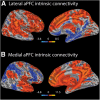Medial and lateral networks in anterior prefrontal cortex support metacognitive ability for memory and perception
- PMID: 24133268
- PMCID: PMC6618531
- DOI: 10.1523/JNEUROSCI.0786-13.2013
Medial and lateral networks in anterior prefrontal cortex support metacognitive ability for memory and perception
Abstract
Convergent evidence indicates that frontopolar Brodmann area 10, and more generally the anterior prefrontal cortex (aPFC), supports the human capacity to monitor and reflect on cognition and experience. An important unanswered question, however, is whether aPFC is a homogeneous region that supports a general-purpose metacognitive ability or whether there could be regional specialization within aPFC with respect to specific types of metacognitive processes. Previous studies suggest that the lateral and medial subdivisions within aPFC may support metacognitive judgments of moment-to-moment perceptual processes and assessments of information from memory stored over longer time scales, respectively. Here we directly compared intraindividual variability in metacognitive capacity for perceptual decisions and memorial judgments and used resting-state functional connectivity (rs-fcMRI) to relate this variability to the connectivity of the medial and lateral regions of aPFC. We found a behavioral dissociation in metacognitive ability for perceptual and memorial judgments. Furthermore, functional connectivity analysis revealed distinct patterns of connectivity that correlated with individual differences in each domain. Metacognitive ability for perceptual decisions was associated with greater connectivity between lateral regions of aPFC and right dorsal anterior cingulate cortex, bilateral putamen, right caudate, and thalamus, whereas metacognitive ability for memory retrieval predicted greater connectivity between medial aPFC and the right central precuneus and intraparietal sulcus/inferior parietal lobule. Together, these results suggest that an individual's capacity for accurate introspection in the domains of perception and memory is related to the functional integrity of unique neural networks anchored in the medial and lateral regions of the aPFC.
Figures





Comment in
-
Dissociable neural networks supporting metacognition for memory and perception.J Neurosci. 2014 Feb 19;34(8):2765-7. doi: 10.1523/JNEUROSCI.5232-13.2014. J Neurosci. 2014. PMID: 24553918 Free PMC article. No abstract available.
References
-
- Baayen R, Piepenbrock R, Gulikers L. The CELEX lexical database (version release 2)[CD-ROM] Philadelphia: Linguistic Data Consortium, University of Pennsylvania; 1995.
Publication types
MeSH terms
LinkOut - more resources
Full Text Sources
Other Literature Sources
Medical
